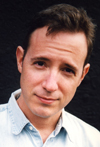Interview Roundup
 The Village Voice chats with graphic novelist Jessica Abel about, among other things, how her comics have often been miscontrued as thinly veiled memoir: “When La Perdida was first serialized [in 2001], everyone assumed it was autobiographical, but as it went along people figured out Carla wasn’t me—or hoped it wasn’t me, given what happens in the book.”
The Village Voice chats with graphic novelist Jessica Abel about, among other things, how her comics have often been miscontrued as thinly veiled memoir: “When La Perdida was first serialized [in 2001], everyone assumed it was autobiographical, but as it went along people figured out Carla wasn’t me—or hoped it wasn’t me, given what happens in the book.”
- As long as we’re talking about comics, here’s an interview with manga legend Kazuo Koike, perhaps best known for Lone Wolf and Cub…but whose Lady Snowblood was a key influence on Quentin Tarantino for Kill Bill. And lest we still have any doubts about the signficance of manga, Koike describes it as “the only new—and perhaps, the last new—commodity that Japan can proudly present to the world.” As he points out, “gross yearly sales in the Japanese automobile industry are 20 trillion yen ($170 billion). Gross sales related to intellectual property, of which manga is a major subset, are 14.7 trillion yen ($125 billion).”
- I was hoping that I’d get to meet Elizabeth Kolbert this weekend at the Virginia Festival of the Book, but our panels are scheduled directly opposite one another. So for now I’ll have to settle for this New Yorker promotional interview for her series of articles on climate control…
- One of the best books I’ve read in the last month is Naomi Novik’s His Majesty’s Dragon, which is basically like Patrick O’Brian, but with dragon riders. Seriously amazing book; it’s a mass-market original coming out any day now from Del Rey, and you’ll want to pick it up. Find out some more in this interview with Novik.
23 March 2006 | uncategorized |
Author2Author: Patrick Ryan & Stephen Harrigan
When Patrick Ryan’s Send Me and Stephen Harrigan’s Challenger Park showed up in my mailbox within a few days of each other, I found their thematic correlations so intruiging that I immediately started thinking about how I could get the two authors talking to each other.
 Patrick Ryan: Reading Challenger Park was like stepping through a looking glass into a parallel universe. I grew up on Merritt Island, Florida, always in the vicinity of astronauts and launches, and have written fiction about characters in the shadows of that whole operation (either as employees with less-than-glamorous jobs or as local residents who just happen to have Saturn rockets and space shuttles climbing into sky over their shoulder while they’re, say, mowing the lawn). Your novel is about actual astronauts, so I felt as if I were reading the story of what was happening on the other side of the glass, so to speak. It was fascinating for me, and interesting that the challenges your characters face are, in some ways, very similar to ones mine face.
Patrick Ryan: Reading Challenger Park was like stepping through a looking glass into a parallel universe. I grew up on Merritt Island, Florida, always in the vicinity of astronauts and launches, and have written fiction about characters in the shadows of that whole operation (either as employees with less-than-glamorous jobs or as local residents who just happen to have Saturn rockets and space shuttles climbing into sky over their shoulder while they’re, say, mowing the lawn). Your novel is about actual astronauts, so I felt as if I were reading the story of what was happening on the other side of the glass, so to speak. It was fascinating for me, and interesting that the challenges your characters face are, in some ways, very similar to ones mine face.
Can you talk a little about how the themes of the book may or may not have affected the writing? I could argue that some of Challenger Park‘s themes are regret, self-disappointment, and certainly isolation. Also, there’s the idea of “Ground Control” and what that means. Many of your main characters are in various states of being “ungrounded” (sometimes literally). Do you feel that these themes helped shaped the book as you were conceiving it (before the actual writing), or that they emerged as you began producing pages? I guess another way to ask that is, did you see the themes on your way in, or on your way out?
Stephen Harrigan: I knew I wanted to write a book about a woman astronaut caught between the pull of her own ambitions and the responsibility she feels toward those who depend upon her on earth, so I guess the theme was there from the beginning, though I didn’t announce it to myself as such. The word “theme” has always uncomfortably reminded me of stultifying classes in high school or college, in which a novel or a poem or a story was presented as something that needed decoding. If you could discover the theme, you could understand a piece of writing in some approved way. But I’d be lying if I didn’t admit that I worried and fretted over the meaning of this book all the way through.
I have a day job as a screenwriter, and because screenplays are such relentlessly efficient narrative machines I’ve fallen into the habit over the years of constantly asking myself questions as I write: what is this book or movie really about? What is it that the character really wants? What is in his or her way? Those sorts of questions can be cripplingly didactic to a writer early in his career, when a certain amount of flailing about is probably necessary and healthy, but later on, when you’ve learned a few things about your limitations, it can be liberating. If you keep posing the right questions to yourself, you can begin to shape the story with a clear purpose in mind. You can see what’s crucial to the story, and what you don’t need to write after all.
Send Me is labelled as “fiction” on the jacket rather than, as is usually the case, “stories” or “a novel.” At first I thought this was just some sort of marketing strategy on the publisher’s part, but after I read four or five of the pieces and began to get an idea of how they fit together, I soon realized that the book was earning its unusual categorization. It’s not a collection of short stories, even though each of the chapters has a kind of stand-alone artistry, and it’s not a novel, even though the book has by the end the force of a sustained narrative. I’m such a literal-minded, one-chapter-after-the-next sort of writer I can’t imagine being able to tell a story this way, and I’m filled with admiration for how beautifully you’ve made this book work.
The way you’ve put it together—continually juxtaposing the past against the future, putting bright scenes of family togetherness in one chapter, then leaping ahead to expose the chilling dissolution of that family in the next—ensures that the reader is always following the fortunes of these people with a haunted awareness of what they are trying to escape from and what is in store for them. So to finally get to my question: Were you consciously focusing on the structure of this book all the way through and writing to achieve a specific overall effect, or did you write the various pieces as they occurred to you and then felicitously found the perfect order in which to link them?
Patrick Ryan: I think I would have the same reaction you did to seeing the moniker “fiction” on the cover (wondering if the book was simply unwilling to commit to being either a novel or a story collection), and I’m delighted that you found an overall sustaining sense of narrative in the book. Calling the book simply “fiction” was actually my idea, and I was surprised and very happy that my editor saw why I wanted to use the term and that she was in favor of it. My earliest conception of the book was of an interwoven series of narratives about a family—six main characters—whose lives constantly intercept and profoundly affect one another. I saw it as a book that would have a half-dozen overlapping arcs, as opposed to one dominant arc that a reader would normally expect from a novel. There were storylines I outlined and never wrote, of course, and some I tried to write and dropped. I played around with the order the parts might be arranged in, but I always wanted them to be presented out of chronological sequence.
To answer your question more succinctly, I did consciously focus on the structure of the book from the first day I started taking notes on it; I just wasn’t sure where all the pieces would land. Some of them, once they were written and revised, clearly announced themselves as wanting to be placed near the beginning or near the end or—as was the case with the longest piece, “Woman in a Fan Chair”—smack dap in the middle of the book. And some of the pieces I moved here and there to see how it would affect the overall narrative.
18 March 2006 | author2author |

 Our Endless and Proper Work is my new book with Belt Publishing about starting (and sticking to) a productive writing practice.
Our Endless and Proper Work is my new book with Belt Publishing about starting (and sticking to) a productive writing practice. 
